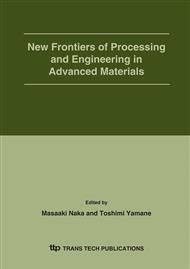[1]
B. Ong, Y. Wu, L. Jiang, P. Liu, and K. Murti: Synthetic Metals 142 (2004), 49.
Google Scholar
[2]
G. H. Gilmer, H. Huang, and C. Roland: Comp. Mater. Sci. 12 (1998), 354.
Google Scholar
[3]
Y. Yao and Y. Zhang: Phys. Lett. A 256 (1999), 391.
Google Scholar
[4]
S. V. Dmitriev, N. Yoshikawa, M. Kohyama, S. Tanaka, R. Yang and Y. Kagawa: Acta mater. 52 (2004), (1959).
Google Scholar
[5]
T. Makino, A. Kubo, E. Sugiyama, and S-I. Tanaka: Interface Science, submitted.
Google Scholar
[6]
L. A. Girifalco and V. G. Weizer: Phys. Rev. 114 (1959), 687.
Google Scholar
[7]
M. J. Frisch et al.: Gaussian 03, Revision B. 04, Gaussian, Inc., Pittsburgh PA, (2003).
Google Scholar
[8]
S. Walter, V. Blum, L. Hammer, S. Muller, K. Heinz, and M. Giesen: Surf. Sci. 458 (2000), 155.
Google Scholar
[9]
J. E. Prieto, Ch. Rath, S. Muller, R. Miranda, and K. Heinz: Surf. Sci. 401 (1998), 248.
Google Scholar
[10]
Z. P. Hu and B. C. Pan: Phys. Rev. B 41 (1990), 9692.
Google Scholar
[11]
Z. Crljen, D. Sokcevic, R, Brako and P. Lazic: Vacuum 71 (2003), 101.
Google Scholar
[12]
M. I. Haftel: Phys. Rev. B48 (1993), 2611.
Google Scholar
[13]
A. Hashibon, J. Adler, M. W. Finnis, and W. D. Kaplan : Interface Science, 9 (2001), 175.
Google Scholar
[14]
A. Hashibon, J. Adler, M. W. Finnis, and W. D. Kaplan : Computational Mater. Sci., 24 (2002), 443.
Google Scholar
[15]
A. Christensen, A. V. Ruban, P. Stolze, K. W. Jacobsen, H. L. Skriver and J. K. Norskov: Pys. Rev. B 56 (1997), 5822.
Google Scholar
[16]
S. H. Overbury and Y. S. Ku: Phys. Rev. B 46, (1992), 7868.
Google Scholar
[17]
V. S. Stepanyuk, D. V. Tsivline, D. I. Bazhanov, W. Hergert, and A. A. Katsnelson: Phys. Rev. B 63, (2001), 235406.
Google Scholar
[18]
A. R. McGurn and D. M. Estering: Phys. Stat. Sol. B105 (1981), 47.
Google Scholar
[19]
M. Hasegawa and W. H. Young: J. Phys. F8 (1978), 81.
Google Scholar
[20]
H. Okumura and F. Yonezawa: Phys. Rev. E67 (2003), 021205.
Google Scholar


